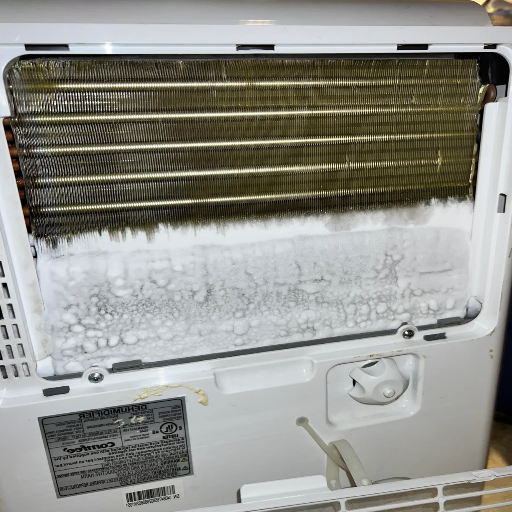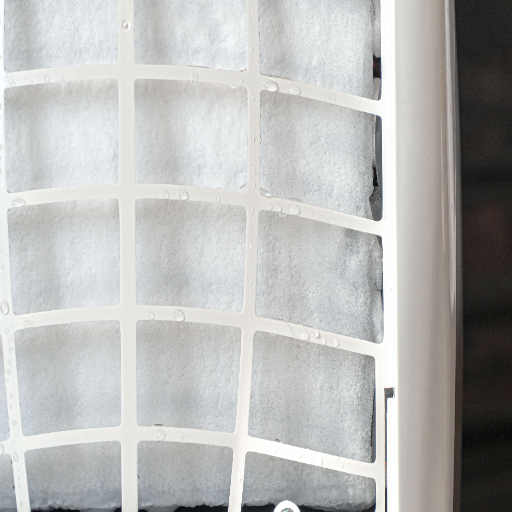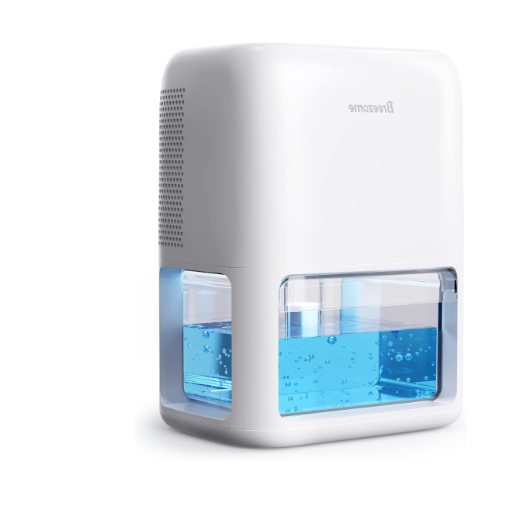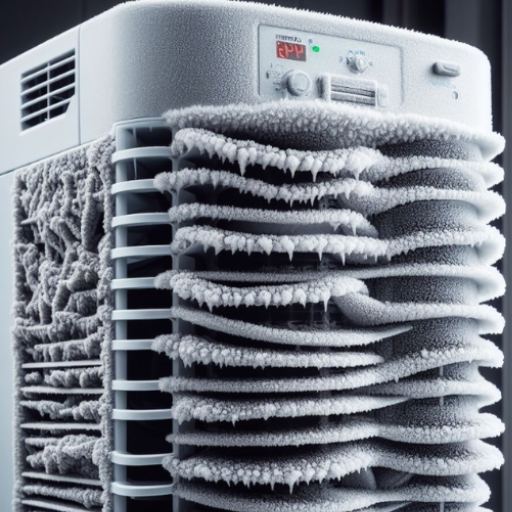Introduction to Dehumidifier Icing

What is Dehumidifier Icing?
Dehumidifier icing is ice formation on dehumidifier coils or internal parts, mostly on evaporator coils. This formation occurs when the surface temperature of these coils falls below 0°C and the air beneath is moist enough to condense and freeze. Such icing occurs mostly in low-temperature conditions, particularly below 65°F (18°C), when the reduction of humidity is not very efficient, and condensation tends to freeze.
The primary reasons for icing in a dehumidifier include:
- Limited airflow due to blocked air filters
- Mechanical malfunctions such as fan failure or temperature sensor issues
- Environmental factors, including low temperature and high humidity conditions
- Poor maintenance leads to dirt accumulation on coils
Why Ice Buildup Occurs
Ice buildup primarily results from environmental conditions and operational factors:
| Cause | Description | Impact |
|---|---|---|
| Low Temperature | Operating below 65°F causes excessive cold on defrost coils | Water freezes instead of draining properly |
| Restricted Airflow | Dust, dirt, or clogs in filters and components | Moisture gets trapped on coil surfaces |
| Mechanical Faults | Malfunctioning thermostat or low refrigerant levels | Creates a system imbalance leading to ice formation |
The Importance of Addressing Dehumidifier Freezing
Stopping the buildup of ice on a dehumidifier helps maintain:
- Unit efficiency and proper moisture removal
- Good air quality in the treated area
- Prevention of mold growth and structural damage
- Extended equipment lifespan and reduced repair costs
4 Common Causes of Dehumidifier Icing
1. Humidity and Temperature Sensor Issues
Faulty sensors can cause incorrect readings, leading to improper defrost cycle activation and eventual ice formation on coils.
- Calibration faults
- Dirt or dust accumulation
- Damaged wiring or connections
2. Restricted Airflow Due to Dirty Filters
Clogged filters prevent proper air circulation, causing the unit to work harder and potentially freeze.
- It can improve performance by up to 50% when properly maintained
- Should be cleaned/replaced monthly to quarterly
- HEPA filters provide enhanced filtration
3. Fan Motor Malfunctions
A failing fan motor reduces airflow over the evaporator coils, creating conditions conducive to ice formation.
- Signs include unusual noises
- Reduced air movement
- Inconsistent operation
4. Environmental Factors
Operating conditions outside manufacturer specifications can lead to icing problems.
- Temperature below 65°F (18°C)
- Excessive humidity levels
- Poor room ventilation
Troubleshooting Dehumidifier Icing
Identifying Signs of Icing
Common indicators of dehumidifier icing include:
- Visible frost or ice on evaporator coils
- Reduced performance in moisture extraction
- Inconsistent humidity control despite continuous operation
- Error codes or warning lights on modern units
- Unit is running constantly without reaching the set humidity levels
Checking Room Temperature and Humidity Levels
Optimal operating conditions for dehumidifiers:
| Parameter | Optimal Range | Notes |
|---|---|---|
| Temperature | 41°F to 95°F (5°C to 35°C) | Operating outside this range can cause performance issues |
| Relative Humidity | 30% to 50% | Prevents mold growth and maintains comfort |
| Minimum Safe Temperature | Above 65°F (18°C) | Below this temperature, increases icing risk |
Inspecting the Dehumidifier for Common Issues
Regular inspection checklist:
- Air Filter: Check for blockages and clean/replace as needed
- Water Collection System: Empty the tank regularly and inspect the drainage hose
- Coils: Look for dirt buildup or frost formation
- Electrical Components: Inspect power cord and control panel
- Performance Monitoring: Check humidity readings and listen for unusual sounds
Preventing Dehumidifier Icing in Different Environments

Best Practices for Cold Basements
- Choose appropriate models with auto-defrost features
- Maintain central placement with clear airflow paths
- Keep temperature above 41°F (5°C) using supplemental heating if necessary
- Regular maintenance, including filter cleaning
- Monitor humidity levels, maintaining 30%-50% RH
- Consider desiccant dehumidifiers for extreme cold conditions
Maintaining Proper Airflow in Poorly Ventilated Rooms
Airflow Solutions:
- Utilize natural ventilation through windows and vents
- Install exhaust fans or energy recovery ventilators (ERVs)
- Use air purifiers with HEPA filtration
- Position fans to create cross-flow ventilation
Managing High-Humidity Areas Effectively
Key strategies for high-humidity environments:
- Monitor environmental parameters using hygrometers
- Select appropriate dehumidifier types:
- Desiccant dehumidifiers for high dew point conditions
- Refrigerant-based units for normal high-temperature, high-humidity conditions
- Improve air circulation with strategically placed fans
- Use smart control systems for real-time adjustments
Recommended Dehumidifiers to Minimize Icing Issues

Features to Look for in a Dehumidifier
| Feature | Benefit | Considerations |
|---|---|---|
| Capacity (PPD) | Matches moisture removal to space size | 50-70 PPD for large basements/commercial use |
| Auto-Defrost | Prevents ice buildup in cold conditions | Essential for operation down to 41°F (5°C) |
| Energy Star Rating | Reduces operational costs | Important for continuous operation |
| Adjustable Humidistat | Precise humidity control (30%-50% RH) | Prevents over-dehumidification |
| Multiple Drainage Options | Continuous operation without manual emptying | Built-in pump or gravity drain systems |
| Quality Filtration | Improves air quality | HEPA or washable filters recommended |
| Low Noise Operation | Suitable for residential use | Under 50 dB for comfortable environments |
| Smart Features | Remote monitoring and control | Wi-Fi connectivity and mobile apps |
Choosing the Right Dehumidifier for Your Needs
Selection guidelines based on application:
- Small Spaces (20-30 PPD): Bedrooms, offices, small rooms
- Large Spaces (50+ PPD): Basements, garages, commercial areas
- Energy Efficiency: Energy Star certification for long-term operation
- Noise Considerations: Models under 50 decibels for living spaces
- Special Features: Built-in humidistats, continuous drainage, anti-freeze protection
Frequently Asked Questions (FAQ)
A: Dehumidifier icing is usually caused by low room temperatures that facilitate ice formation on evaporator coils. When room temperature falls below 65°F, the dehumidifier struggles to maintain adequate airflow, resulting in ice formation and reduced efficiency.
A: Keep the unit in a room where the temperature stays above 65°F. Ensure air filters are clean and sufficient airflow exists around the unit. Avoid placement in cold crawl spaces or basements with low temperatures.
A: Unplug the unit and allow ice to melt completely. Check for airflow restrictions and ensure the evaporator coil is clean. If problems persist, relocate to a warmer room or check humidity/temperature sensors for faults.
A: Yes, dirty air filters restrict airflow, which often leads to icing. Reduced airflow decreases operational efficiency, causing ice formation on coils. Regular filter cleaning or replacement ensures optimal performance.
A: Minor frost may be normal during operation, but excessive ice buildup indicates a problem. This usually results from low room temperature, poor air circulation, or faulty fan motor. Address these issues for optimal performance.
A: The four common causes include: 1) Low room temperature, 2) Poor airflow due to dirty filters, 3) Malfunctioning fan motor, and 4) Issues with humidity or temperature sensors. Addressing these factors prevents ice buildup.
A: Most dehumidifiers operate efficiently above 65°F. Running in lower temperatures can cause freezing and ice buildup. For consistently cold environments, consider models specifically designed for cooler conditions.
A: Start by unplugging the unit and allowing complete ice melting. Check and clean the air filter, ensure adequate airflow, and consider relocating to a warmer area if temperatures are too low. Consult a technician if issues persist.
References
- Icing Mitigation in Aircraft Thermal Management: Study exploring icing issues in heat exchangers and turbines, including membrane dehumidifier applications.
- Cold and Humid Environment Simulation for De/Anti-Icing Fluids: Research evaluating de/anti-icing fluid performance through numerical analysis and experiments.
- Anti-Icing/Deicing Capability of Superhydrophobic Coatings: Investigation of advanced anti-icing strategies using superhydrophobic coating technologies.




